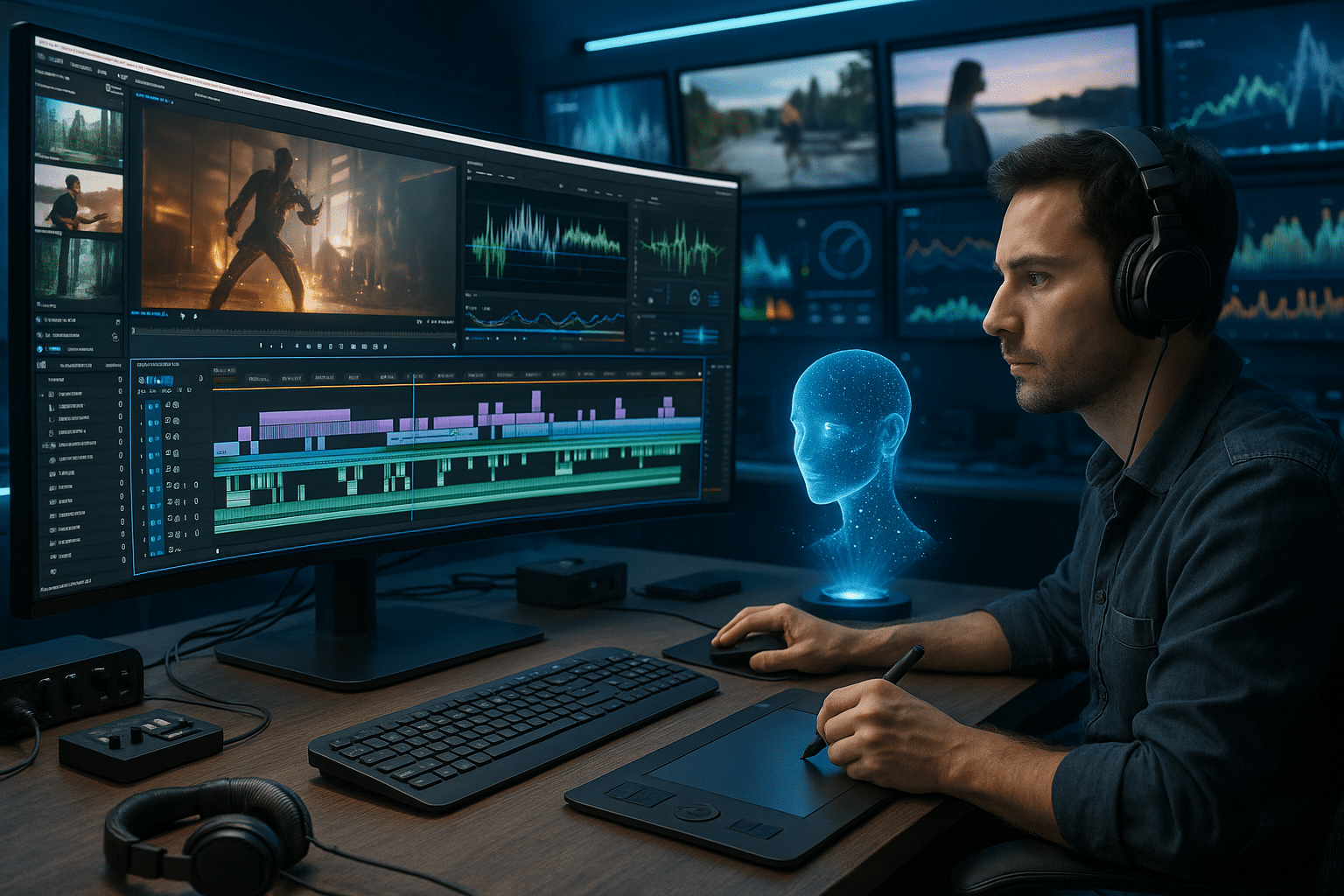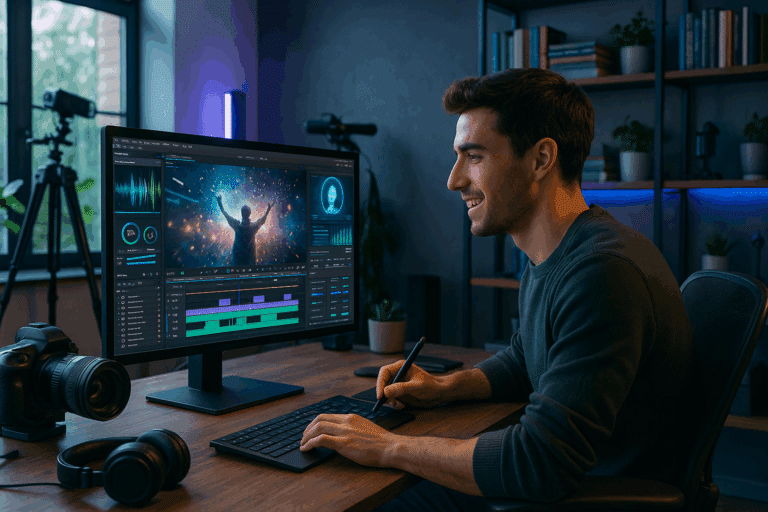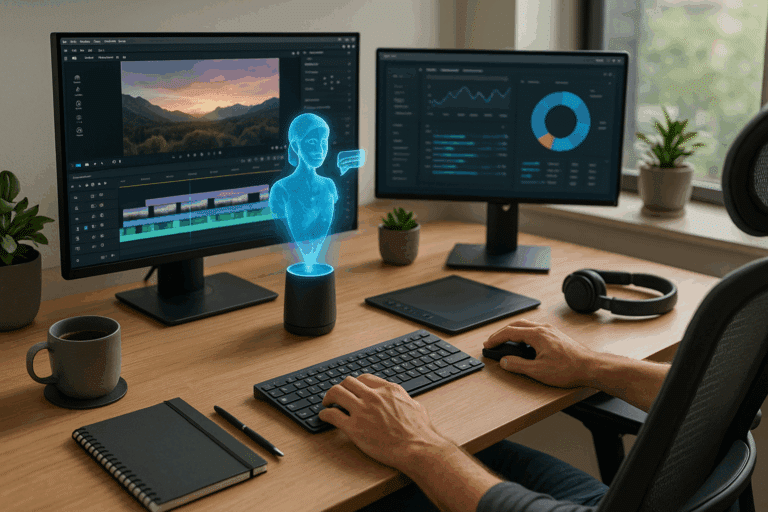Each one is working diligently, their expertise apparent in their swift, confident movements. Suddenly, a hushed silence descends. A machine springs to life with the potential to automate all their work, boasting an efficiency and precision that surpasses human capacity. 😮 This isn’t a plot of a dystopian sci-fi movie, but a peek into the future of video production—powered by Artificial Intelligence (AI). Welcome to the revolution in editing: the next frontier of AI in video production.
The world of video production is poised for a seismic shift, thanks to the relentless march of AI technology. A game-changer, AI is all set to democratize video production, making it faster, more efficient, and accessible to everyone, regardless of their technical proficiency. In this article, we’ll take a deep dive into the AI-powered revolution in video editing, exploring its current state, its potential, and the ripple effects it could have on the industry.
First, we will delve into the mechanics of AI, providing a brief overview of its underpinnings, and how it has begun to intertwine itself with the video production process. 🔧 Next, we will look at the ways AI is currently being utilized in video production, from automated video editing and optimization to the generation of content. We’ll take a look at how AI is fundamentally altering the landscape of video production and what this means for industry professionals.
Of course, no discussion about AI and video production would be complete without considering the ethical implications. 🧐 The rise of AI-driven technologies like deepfakes is a testament to the potential power of this technology, and with great power comes great responsibility. We will delve into the ethical concerns surrounding AI in video production, exploring the potential pitfalls and the measures needed to ensure ethical usage of this technology.
Lastly, we will gaze into the crystal ball to envision the future of AI in video production. With AI technologies evolving at an unprecedented pace, it’s critical to understand what lies ahead. Will AI completely replace human video editors? Or will it function as a tool to enhance their capabilities? We’ll explore these questions and more, providing insights into the possible future scenarios of AI in video production.
From Hollywood movie sets to your local newsroom, the video production industry is on the cusp of an AI-led transformation. 😃 As the curtain lifts on this new era, it’s time to understand the ramifications of this change, the opportunities it presents, and the challenges it brings. So, fasten your seatbelts as we embark on this journey to explore the next frontier of AI in video production. Ready? Action!
The Emergence of AI in Video Production: A Game Changer
The rise of artificial intelligence (AI) technology is swiftly changing the landscape of various industries, and video production is no exception. This progression is not just about automating mundane tasks. It’s about reshaping the whole process of video editing, from the planning stage right through to the final output. This transformation is leading to a revolution in video production, rendering it more efficient, cost-effective, and creative.
AI is not a mere buzzword anymore; it has become an essential tool. In this context, it’s important to delve into this tech-driven revolution and understand how it’s shaping the future of video production. Moreover, there is a need to highlight the comparison between traditional video editing methods and AI-driven video editing to bring out the stark differences and advantages of the latter.
Let’s start our exploration with a quick review of the traditional video editing process and its challenges. After that, we will dive into the exciting world of AI-powered video editing, its benefits, and its potential impact on the future of video production. A detailed comparative table will be provided to illustrate the fundamental differences between these two approaches.
The Traditional Video Editing Process and Its Challenges
Traditional video editing is a time-consuming and labor-intensive process that requires expertise and meticulousness. It involves several steps such as video ingestion, logging, rough cut creation, fine-cut creation, special effects, sound design, color correction, and finally, rendering and exporting the final product. Each of these steps demands a lot of effort, precision, and time.
Moreover, the traditional process is fraught with challenges. Editors often have to deal with extensive amounts of raw footage, from which they need to identify the best shots. This process is not only painstaking but also prone to human error. Furthermore, post-production processes such as color grading and special effects demand specialized knowledge and skills. Even after the video is edited, it needs to go through numerous revisions, which adds to the overall time and cost of production.
Given these challenges, there is a growing need for a solution that can streamline the editing process while ensuring high-quality output. This is where AI comes into the picture.
AI in Video Editing: The Future is Here
The integration of AI in video editing is rapidly transforming this field, making the process more efficient, precise, and creative. AI tools can automate various tasks, such as video trimming, color correction, and sound design, thus reducing the workload of video editors. But the capabilities of AI extend far beyond automation.
For instance, AI can analyze large volumes of raw footage and identify the best shots based on predefined criteria. It can also suggest edits, create transitions, and even add special effects. The application of AI in color grading is particularly impressive. With AI, you can automatically match colors between shots, correct colors, and even apply a specific color grade based on the mood of the scene.
Another exciting aspect of AI in video editing is its ability to generate synthetic media, also known as deepfakes. With the right AI tools, you can create highly realistic videos of people saying or doing things they never did. Although this technology has sparked ethical concerns, it also opens up new creative possibilities in filmmaking and video production.
Comparing Traditional Video Editing and AI-Driven Video Editing
To further understand the impact of AI on video editing, let’s compare the traditional process with the AI-driven process. The following table highlights the main differences between these two approaches:
| Traditional Video Editing | AI-Driven Video Editing | |
|---|---|---|
| Efficiency | Time-consuming process due to manual handling of each step | Significantly faster as AI can automate several tasks |
| Precision | Prone to human error, especially in identifying the best shots from extensive raw footage | Highly precise as AI can analyze large volumes of footage and identify the best shots |
| Creativity | Limited by human capabilities and the time constraints of manual editing | Enhanced creativity as AI can suggest edits, create transitions, and add special effects |
| Color Grading | Requires specialized knowledge and skills | Automated and more accurate with AI tools |
| Synthetic Media | Not possible with traditional editing tools | Can create highly realistic synthetic media using deepfake technology |
How AI is Shaping the Future of Video Production
AI is not just revolutionizing the current state of video production; it is shaping its future. With continuous advancements in AI technology, the possibilities are expanding. In the future, we might see AI tools that can script a video, direct it, and even act in it.
Moreover, AI is democratizing video production. As AI tools become more accessible and user-friendly, more people, even those without formal training in video editing, will be able to create high-quality videos. This democratization will lead to an explosion of creativity and innovation in video content.
There is no doubt that AI is the next frontier in video production. It is not only making the editing process more efficient and creative, but it is also opening up new possibilities that were unthinkable a few years ago. So, whether you are a professional video editor or a hobbyist, it’s time to embrace AI and ride the wave of this exciting revolution.
Learn More About AI in Video Production
If you want to delve deeper into the world of AI in video production, I recommend watching the following video from the YouTube channel “Tech Vision”: “AI in Video Production: The Future is Here”. This video provides a comprehensive overview of how AI is transforming video production, with real-world examples and expert insights. So, don’t wait; hit play and start exploring!

Conclusion
In conclusion, we have ventured into an expansive world of information technology and engineering, with the primary goal of demystifying complex concepts for the everyday professional. Our journey has covered a range of topics, from software development methodologies to the intricate details of IT infrastructures. The significance of these topics in today’s ever-evolving digital world is undeniable, hence the importance of understanding them cannot be overstated.
A recap of our discussion reveals the vastness of the IT and engineering field. We began by exploring the dynamic nature of software development methodologies, including Agile and DevOps, stressing their essentiality in promoting efficiency and adaptability in the development process. We also analyzed IT infrastructures, their components, and their role in supporting and enabling business operations.
As we ventured further, we dived into the realms of cloud computing, cybersecurity, and data analysis, all critical elements in today’s data-driven business landscape. These segments served to underline the integral role of these technologies in enhancing operational efficiency, data security, and informed decision-making.
Each concept we tackled served as a piece of the complex puzzle that is the IT and engineering world. Nevertheless, despite the technicality of these concepts, we strived to present them in a manner that is comprehensible and engaging to professionals across different fields. We hope that the insights shared have added value to your professional journey, equipping you with the knowledge you need to thrive in this digital age.
As we conclude, we invite you to keep the conversation going. We highly encourage comments, shares, and application of the knowledge gained. By doing so, we not only broaden our understanding but also contribute to the global knowledge pool.
This article aims to inspire and empower you to delve deeper, explore further, and constantly challenge yourself to understand the complexities that surround the world of IT and engineering. You are also welcome to explore more on the mentioned topics through the following active research links: Your Link, Another Link and Final Link. 👩💻🌐📚
Ultimately, the key to grasping these complex concepts lies in your willingness to learn and adapt. The more we engage with these topics, the more proficient we become. Therefore, let’s continue learning, sharing, and applying these insights, as we navigate the intriguing world of IT and engineering.
Remember, the goal is not to overwhelm but to enlighten and inspire. So, let’s strive to keep learning, growing, and excelling in our respective fields. After all, knowledge is power, and with power comes great responsibility.
So, keep exploring, keep questioning, and keep innovating. The world of IT and engineering awaits you, and the possibilities are endless. Thank you for your time and engagement. Until next time, happy exploring! 👨💻🔬🚀
And finally, if you found this article useful, feel free to share it across your networks. Your feedback is also greatly appreciated, so do leave a comment below. 💡💼🌐



